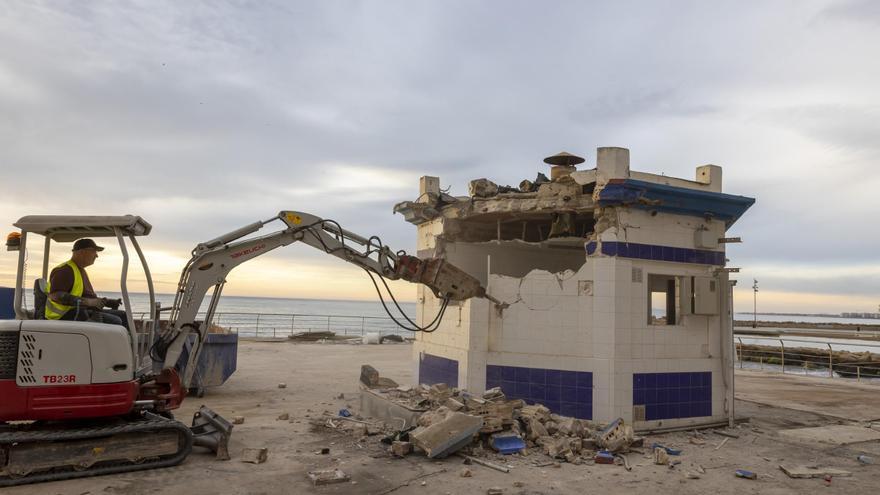The demolition of the El Tintero kiosk is part of a process whose fatal outcome corresponds to compliance with the Coastal Act. We have to go back to 2012, the end of its administrative concession, when the concessionaire took legal action to avoid what happened now. Attempts to save this symbolic building by the local administration are limited to the former mayor, José Manuel Dolon (Los Verdes), who in 2019 launched a declaration of assets of local importance – an initiative that fell through when he lost the election – and the current mayor Eduard Dolón (PP), who returns to the issue in February 2023, i.e. four years later, albeit bad and late because we all already know the outcome.
The sad disappearance of El Tinter is another attack on the identity of Torrevieja. There are so many attacks on the urban-architectural heritage of Torrevieja that we could declare that the Torrevieja we knew has died.
The paradox is that the death of Torrevieja’s identity was not caused by those who defended the protection of our symbolic buildings and proper construction against a la carte urban planning – which the People’s Party called anti-Torrevieja. The execution of Torrevieja was carried out by the local governments of the People’s Party, they are the real anti-Torrevieja.
All of us who were born or lived here for at least fifty years have lost all the urban elements that served us as a reference. In that Torrevieja, in which responsible parents could allow children under the age of ten to go to school alone or to leave their homes and discover other neighborhoods, we children learned to orient ourselves by looking at the location of houses or unique buildings. So we visited the Salt Eras, the Doña Sinforosa hut, the Dulce kiosks, Antonio or Tintero, the fish market, the Nuevo cinema, the barracks, Torrejón, the temple, Rosper’s house, the García and Montero towers, the siege of Casciaro, the summer cinemas (Las Rocas, Oriente, Terraza Jardín , Segovia, Las Salinas, Gloria, Royal…) or an old hermitage.
Almost at the end of the 1980s, the PP came to power in the Torrevieja City Council, when there was a construction boom accompanied by corresponding crises. In all that time, Torrevieja has grown, the land has been exhausted but not developed, and all our landmarks are disappearing, replaced by a swarm of buildings without any architectural value.
Unfortunately, we have little in common with the development from which cities in the north of the province benefited, such as Altea, Villajoyosa, Jávea or Denia, in which, together with urbanism at the service of citizens, they protected their fisheries. neighborhoods and their typical buildings to gain uniqueness and become attractive tourist destinations.
In spite of some of us, we have seen the village grow chaotically and lack any planning. For example, the only structuring instrument of the territory, the PGOU, has been modified hundreds of times by the PP, almost always in the service of false economic interests. And all this in exchange for what? The answer is, of course, in exchange for the loss of the city’s identity, but not for improvement, because today we have a population of almost 100,000 inhabitants, which lacks the good things of 21st century cities, such as wide sidewalks and avenues, large pedestrian areas, cycling. paths, green areas and urban gardens. Or how the Tourism Development Strategy of Torrevieja, prepared by the University of Alicante in 2018, includes in its diagnosis, in exchange for the degradation of the image of the city, the perception of a dangerous city, a dirty city with the absence of an associative structure.
It is the Tourism Development Strategy that considers heritage qualification and improving our services through planning to be the most appropriate for the future of our city. He further rejects that the public power embarks on star projects that, however many millions they may cost, do not satisfy the structural ailments that the city suffers from, but the People’s Party has a different opinion. These anti-Torrevieja feel more comfortable to remove with a stroke what stands in their way or to let time pass to do its job, it is the same thing they have done in more than thirty years of their local government. As examples, some elements of the list of assets classified in the PGOU as elements of urban architectural interest that no longer exist or are in a dilapidated situation; namely the offices of the Salinera company, the building of the new cinema, the house of Mr. López Dols, the Posada de El Parejo, the lodge of El Palangre, the ice factory, the Ermita del Cerco de Casciaro, the house and the tower of Los Balcones. Surely someone can add some element, even Pascual Flores, oh Pascual Flores!
El Tintero was an opportunity for the ruling People’s Party team to show that they really care about our past, but they arrived wrong and late. A few weeks ago it was known that they would try to save the Minguez pier, but again they arrived late and bad, because a few months ago part of this pier was used to expand the RCNT parking lot. They could have defended themselves in the port so that the fish market buildings were not demolished, but they arrived badly and late (or at all).
In recent weeks, the Group of Socialist Councilors of the Torrevieja City Council revealed an agreement expressing the intention of the local PP government to unblock the Civil Guard barracks so that a hotel could be built without having to respect the structure. and the current facade of the building.
Nothing is known about the Civil War shelters or chemistry buildings at Las Salinas. Ask the anti-Torrevie people in the People’s Party, even if you already know that if they answer you, it will be too late.

